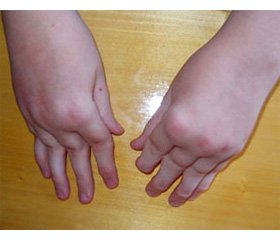Журнал «Боль. Суставы. Позвоночник» 2 (18) 2015
Вернуться к номеру
Joint Pain Perception Features in Children with Juvenile Rheumatoid Arthritis and Their Parents
Авторы: Kovalchuk T., Boyarchuk O., Hariyan T. - Ternopil State Medical University named after I.Ya. Gorbachevsky, Ternopil, Ukraine
Рубрики: Ревматология, Травматология и ортопедия
Разделы: Медицинские форумы
Версия для печати
Статья опубликована на с. 89-90
Introduction. Juvenile rheumatoid arthritis (JRA) is a chronic disease that requires a doctor’s constant assessment of the patient’s condition for timely decision about important changes in therapeutic tactics. In the clinical picture of the disease the center place pain is belongs.
The aim of the research was to determine peculiarities of pain perception by suffering from juvenile rheumatoid arthritis children and their parents.
Materials and methods. The 99 children were examined — 60 sick by JRA patients and 39 healthy children. Selected groups were matched by the sex, age, and nationality. The intensity of joint pain was assessed by the using of visual analogue scale (VAS) in children and their parents. Children aged 6–10 years were interviewed by VAS with pictures that reflect the grimaces of pain. Patients above 10 years and their parents were interviewed by simple VAS.
Results. Established that patients with JRA and their parents had given the same assessment of articular pain intensity (3.5 ± 0.3 cm, 4.5 ± 0.6 cm; p > 0.05). In the group of healthy children the average body pain during the last week was 0.5 ± 0.2 cm by children assessment, and 0.6 ± 0.2 cm by parents assessment (p > 0.05). The level of pain intensity determined in accordance with the VAS gradation revealed the following features. 7.1 % of patients with JRA didn’t feel joint pain during last week (0 cm). 41.1 % of children had mild pain (0.1–3.9 cm), 33.9 % had moderate pain (4.0–5.9 cm), 17.9 % had severe pain (6.0–7.9 cm). Their parents indicated absence of joint pain in 6.8 % of children, mild pain in 42.4 %, moderate pain in 33.9 %, severe pain in 10.1 %, very severe pain in 6.8 % (8.0–10.0 cm).
Depending on the therapy all patients were divided into two groups. Children of the first group (n = 24) received basic therapy with a low–dose of methotrexate (7.5 mg/m2 of body surface per week). Kids of the second group (n = 29) received nonsteroidal anti–inflammatory drugs monotherapy. The monitoring of pain syndrome during treatment showed significant reduction of pain intensity in the first group only. Children felt decrease joint pain 2 years after the date of initiation a low–dose of methotrexate (4.1 ± 0.4 cm, 1.6 ± 0.3 cm; p < 0.05). However parents indicated that the level of pain decreased already one year after conducted basic treatment (4.3 ± 0.4 cm, 3.3 ± 0.3 cm; p < 0.05).
In some foreign studies were conducted a comparative analysis of the results VAS use by parents and their children. S.D. Lal et al. have shown that the results of the evaluation of pain perception between parents and children coincide in 71 % of cases [1]. In the articles of P. Garcia–Munitis and others, G.J. Reid et al. were shown that parents very often underestimate the value of children’s pain [2, 3]. In our study we obtained the opposite results. Calculation of the coefficient of diagnostic value by the Zemskov formula showed equally informative results of pain perception assessed by sick JRA patients and their parents (Ki = 3.41 in both –cases).
Conclusion. The results helps to conclude that in Ukraine parents interested in their children’s well––being and well informed in their real state of health. If necessary the results of evaluation of pain in patients and their parents with help of VAS can be interchangeable.
1. Agreement between proxy and adolescent assessment of disability, pain, and well–being in juvenile idiopathic arthritis / S.D. Lal, J. McDonagh, E. Baildam [et al.] // J. Pediatr. — 2011. — Vol. 158, № 2. — P. 307–312.
2. Level of agreement between children, parents, and physicians in rating pain intensity in juvenile idiopathic arthritis / P. Garcia–Munitis, M. Bandeira, A. Pistorio [et al.] // Arthritis Rheum. — 2006. — Vol. 55, № 2. — P. 177–183.
3. Reid G.J. Parent–child interactions among children with juvenile fibromyalgia, arthritis, and healthy controls / G. J. Reid, P.J. McGrath, B. A. Lang // Pain. — 2005. — Vol. 13, № 1. — P. 201–210.

